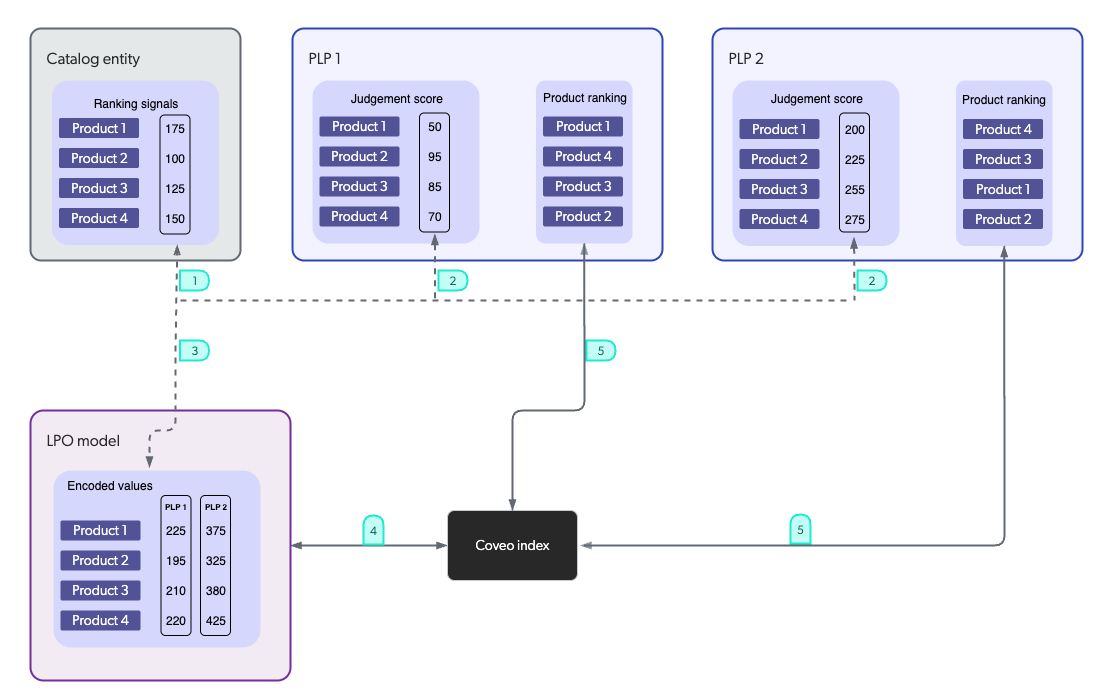About Listing Page Optimizer (LPO)
About Listing Page Optimizer (LPO)
|
|
Contact your Coveo representative to enable Listing Page Optimizer (LPO) in your Coveo organization. |
Coveo Machine Learning Listing Page Optimizer (LPO) leverages AI to dynamically optimize product rankings on product listing pages (PLPs), ensuring the most relevant products appear first to maximize the revenue and conversions generated from Coveo-powered PLPs.
To achieve this, LPO analyzes contextual behavioral data, such as clicks and purchases on each PLP, and combines it with global business KPIs associated with each product, such as revenue and clickthrough rates. This approach allows LPO to assess product performance both within specific listing contexts and across the entire storefront. Using these combined signals, LPO determines the optimal product order for each PLP in your commerce storefront.
|
|
Note
While LPO automatically optimizes product ranking, merchandisers can still manually adjust the ranking of products on PLPs using the Coveo Merchandising Hub (CMH) or query pipeline rules. |
By using LPO in your Coveo-powered PLPs, you:
-
LPO ranks all products on a PLP, prioritizing those that are most likely to lead to a conversion, thereby increasing the likelihood of user engagement and conversion.
-
Reduce manual tuning: LPO minimizes the need for extensive manual pinning, boosting, and burying of products.
-
Favor data-driven decisions: Merchandisers can leverage AI insights instead of manually adjusting product rankings.
Prerequisites
Before contacting your Coveo representative to enable LPO in your Coveo organization, make sure that you:
-
Have configured a catalog entity.
-
Make sure that the standard commerce fields are populated and mapped in your catalog entity.
-
-
Have built listing pages and configurations.
-
Track commerce events on your PLPs.
-
Use a tracking ID to identify the storefront where you want to integrate the model.
How Listing Page Optimizer works
LPO analyzes the products returned for each PLP in your Coveo organization and ranks them based on various factors.
The following diagram illustrates the LPO workflow:

-
For each product defined in the target catalog entity, LPO computes ranking signals. These signals summarize how well a product performs in your storefront based on user engagement and conversion data. Factors such as clickthrough rates, conversion rates, and product popularity are considered.
-
Every time a user visits a PLP, a listing query is sent to the Coveo index to retrieve the products for that PLP. LPO evaluates how users interacted with products on that specific PLP in the past and assigns a judgement score to each product, reflecting its contextual relevance for that PLP. Usage analytics data, such as clicks and purchases for a specific PLP, are used to determine these scores.
-
Using the ranking signals and judgement scores, LPO generates a set of encoded values for each product in the catalog entity. Each encoded value represents the predicted performance (relevance score) of that product for a specific PLP, based on historical interactions and behavioral patterns observed for that context.
-
These encoded values are sent to the Coveo index where they’re stored as fields, enabling their use at query time.
-
When a user browses a PLP, a listing query triggers the model. LPO identifies the PLP and applies a ranking function, which retrieves the relevant encoded value for that PLP from the product’s stored fields. This value is then combined with the default index score to determine the final product ranking.
LPO models update automatically every 24 hours, ensuring that recent user interactions are taken into account in the ranking.